H.G.CO. Petticoat Beehive
by Paul L. Rosenberger
Reprinted from "Crown Jewels of the Wire", August 2001, page 29
Like all other ventures, the collecting of insulators has been a combined
effort on the part of myself, my son Paul and daughter Paula.
It didn't take
long for us to decide on specializing on a CD more common to our area. This
proved to be CD 145 H.G.CO. PETTICOAT beehives.
All this was during the early
1970's; and when we began to have duplicate colors we found different letter
embossings so we began a mini-collection within the framework of the whole.
The
quest began. There are several styles, but they are all beehives and they fall
into five categories:
- Those with no letter
- Those with only a dome letter
- Those with letters above the H. G. CO.
- Those with letters below the H.
G. CO.
- Those with letters below the PETTICOAT
We now have over 250
insulators with the most color among the J's, K's and no letters.
I would like to
thank the Lord for watching over us on our quest protecting us from bees, wasps,
mosquitoes, barbed wire, thorny bushes and railroad cars with struggling cables.
Hiking, bicycling, but no pole climbing, has made creating this collection a
great adventure.
Paul Rosenberger
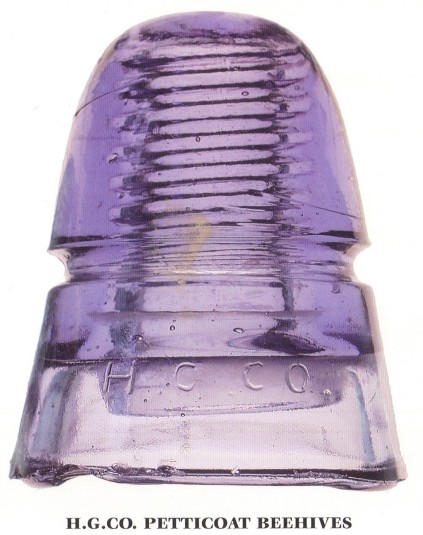
Cover Photo
The H.G. CO Petticoat beehive is a railroad insulator and as such can still
be seen on telegraph lines along rail lines that remained unmolested for years.
But as mentioned in the July issue of CJ, the poles along the railroads are
coming down. Heavy equipment and even the heavy snows of winter have resulted in
downing the base rotted poles of many a rail telegraph line. What we are seeing
is the end of rail walking for glass and the final elimination of the source of
a major CD 145 variant, the HG petticoat.
Our insulator hunting started in
Elgin, Illinois where we have the Union Pacific (old Chicago Northwestern), the
Milwaukee, and the old Aurora-Elgin electric line. You might even include the
Illinois Central and Great Western if you were to push the town boundaries a
bit. With this combination, you had the making of some great insulator hunting
in the 70's and 80's and the start of a love affair with the HG petticoat
beehive.
The magical beehive embossed "Petticoat" that has entertained my
father, sister, and myself for 31 years of insulator hunting and collecting.
Your editor has put together a terrific display of not just color, but the
embossing variants that get some of you hooked, intrigued, and just waiting for
the next show when you can pick up one of these gems. The shape is a
"classic", the embossing is varied, and the colors unpredictable.
There are skirt differences, dome differences, embossing differences, and the
wild cards that surprise you.
It seems we go in cycles in this hobby where a
certain CD is "hotter" than the others. Right now I'm told Mickey
Mouse's are "heating up" again, CD 162 signals are hot, and beehives
were hot but not as hot as signals. One hears at the shows how the
"prices" of this CD or that CD have just gone sky high and the
non-specialist refuses to put his "parachute" on and jump in to the
melee. Well, I think the prices on rarer petticoats have all but bought tickets
for the space shuttle and I sometimes question if "to the moon" is as
high as they can go. But don't let the prices of some let you dismiss the
overall collectability or availability of some very nice glass for some very
reasonable prices. You can collect HG petticoats on a budget and put together a
rather impressive display case and what can be better than a starter collection
that has room for growth.
Many of you may not have even realized there were
collectors that push the limits of "weird" to collect and specialize
in a particular embossing of HG petticoat. Some of you have been fortunate or
unfortunate enough to receive an email or call from me asking "what letter
is on that petticoat you have for sale". So for all you petticoat
collectors and for those nonbelievers out there, lets start our trip into
"weird".
I know of five basic ways to collect petticoats and correct
me if you collect a different way.
- Color
- Narrow skirt versus wide skirt
- Mold letter (skirt/dome)
- Mold letter Variants within a single mold letter/ tall dome
- Goobers/snot,
milky streams, snow or bubbles, pot stones, impurities, heavy pours
COLOR
Generally speaking, darker is better. Recently the "catalogs" have
defined blue teal and green teal for us, probably more as a marketing ploy than
anything else, but it gave credibility to a semi-hard color that would otherwise
be left as "dark aqua". Pea soup became a color and one that costs a
lot more than your average bowl of Campbell's. It is a hard color to find and
they probably should have put it on the new Pennsylvania quarter. It would have
looked a lot better than a 'keystone".
The emphasis on "dark"
colors has lead to what I think is a great opportunity to collect in the
pastels. Most of these don't jump at you from a sales table but put them in a
lit display case and you'll be surprised. The letter J and I offer various tints
of blues that sometimes just glow.
So I'll rank the colors from hardest to
easiest in the most general sense. Remember, just like other insulator CD, what
is a twenty-five cent color in one petticoat is "gold" in a different
petticoat. This is only an opinion from offerings I see at shows etc.
|
1) White milkglass |
11) Forest green |
|
2) Dark lavender |
12) Cornflower blue |
|
3)
Sapphire blue |
13) 7-up/ J mold green |
|
4) Blue milkglass |
14) Teal |
|
5) Olive/Pea
Soup |
15) SCA |
|
6) Pink |
16) Lemon |
|
7) Yellow |
17) Light lavender |
|
8) Depression green |
18) Hemingray blue |
|
9) Amber |
19) Clear |
|
10) Purple |
20) Aqua variations |
The most abused color description is the "apple" or
"lime" green. I haven't listed it in the colors because the shades of
green go from very light almost depression. Then there is sage green and celery
green. Well Bam! Bam! I just gave it some essence and now we are cooking with
Emeril. Green is over cooked but it's a comer. Once the poles are down you'll
have wished you had kept more of these. The look great in that lit cabinet.
NARROW SKIRT
This is a "slicker" style of petticoat beehive that is thought to
be of more recent issuance because of its refined appearance and smaller
economical shape. It comes in four known colors: aqua, light aqua, light green,
and purple. I have been told the variations of purple are such that you can
collect just those. The common purple is light to medium in shade. I have not
seen a royal purple but have been told they exist and are so dark you can hardly
see though them which is not the case in the medium purple. A characteristic of
this style is annealing/stress cracks in the skirt. Don't hold your breath
looking for one without them. This variation doesn't have skirt letters but dome
letters A, B, C are known to exist. From a distance it looks much like some
thinner style Brookfield beehive.
MOLD LETTER / MOLD LETTER VARIATIONS
The HG petticoat can carry a mold mark in two places: the dome and the skirt.
The dome letter mayor may not be in combination with a skirt letter. The letters
are: A, B, C, D, E, G, H, I, J, K, L, M, backward N, upside-down and backward C,
and upside down L. The position of the skirt letter can be above or below the
HG.CO on the front or below the word petticoat on the rear. Please reference the
black/white photos for examples of letter placement.
To become aware that the
mold letters are special also opens your eyes to the distinct differences in the
beehive mold characteristics. For instance, the mold A petticoat has a
distinctive but almost unseen flair to the skirt the other mold letters don't
have. The E mold has a more rounded dome and shorter inner skirt and if you ever
compared an orange amber E to an orange amber M, you can see what dome shape and
depth of inner skirt can do to show the same color two different ways. Because
of the extended inner skirt the "M" orange amber shows darker while
the mold "E" orange amber glows because the shallow inner skirt allows
the light through.
The J mold has a distinctive narrow and pointy dome and the L
mold / upside down L are prone to heavy pours and the appearance of what some
would call a "third" petticoat. A third ring of glass appears on the
inside of the outer petticoat as a result of too much glass in the mold. The K
mold has the tall dome, flat top dome, and a pyramid like symmetry of an angled
dome.
The dome lettered and no letter petticoats almost appear to be from
reworked A through backward N molds. There is little doubt in my mind that the
backward N molds were re-machined and used without skirt letters.
|
FRONT SKIRT EMBOSSED BELOW THE WORD "H.G.CO."
|
|
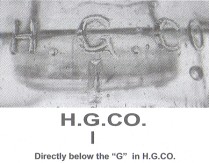 |
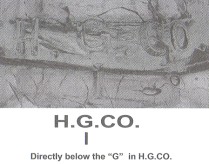 |
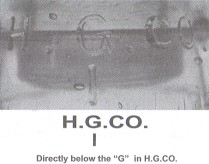 |
In the "I" letter molds, there are three different styles of the
letter "G" in H.G.CO.

|
|
|
|
|
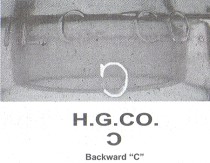
|
The letter could be a "G" backwards and upside-down, but it matches
a backwards" 'J" as typed in quotes here. The letter is a very small
letter in relationship to every other skirt embossed letter. |
|
|
Front Skirt Embossed -
BELOW the word H.G.CO. |
|
Letter |
Mold Count |
Description |
|
I |
3 |
Directly below "G" in H.G.CO.;
3 different letter
styles of "G" in H.G.CO. |
|
J |
2 |
Directly below "G" in H.G.CO.; in
"petticoat"
the "CO" are elevated from the baseline.
Under
right side of "G" in H.G.CO.; "O" in "petticoat"
is slanted. |
|
C Backwards |
1 |
A smaller letter than every other skirt letter used. |
|
|
|
FRONT SKIRT EMBOSSED ABOVE THE WORD "H.G.CO."
|
|
|
|
|
|
|
|
|
Front Skirt Embossed - ABOVE the word H.G.CO. |
| Letter |
Mold Count |
Description |
| K |
3 |
Back leg of "K" is directly above
period after H.G.
Back leg of "K" is above the "G" in H.G.
Back leg of "K" is between the "G" and "CO." |
| upside-down
L |
1 |
"CO" in petticoat are spaced wider than normal |
| L |
2 |
Directly above period after H.G.; petticoat is in small letters.
Directly
above period after H.G.; petticoat is in large letters. |
| M |
3 |
Left leg of "M" is directly above period after H.G.
Center of
"M" is directly above period after H.G.
Left leg of "M" is
directly above period after H.G.;
H.G. are squished together |
| backwards
N |
3 |
Large script letters in H.G.CO.; "N" has three feet
crossed
Small H.G.CO.; "N" has three feet crossed
Small H.G.CO.;
"N" has three feet crossed; "A" and "T" in
petticoat are widely spaced. |
| N |
none |
No letters after "N" have been
reported. |
|
|
|
REAR SKIRT
EMBOSSED BELOW
THE WORD "PETTICOAT"
|
|
|

|
|
|
|
|
|
|
|
|
|

|
|
|
|

|
|
Rear Skirt Embossed - BELOW the word
PETTICOAT |
| Letter |
Mold Count |
Description |
|
A |
1 |
Directly below the "I" in
petticoat. |
|
B |
4 |
Directly under the second "T" in petticoat.
Directly between
the second 'T' and "I" in petticoat.
Directly under the "I"
in petticoat.
Word "PETTICOAT" is slanted to the right, letter by
letter. |
|
C |
1 |
Directly under the "I" in petticoat. |
|
D |
2 |
Directly under the "I" in petticoat.
Directly between the
second "T" and "I" in petticoat. |
|
E |
3 |
Directly between the second "T" and "I" in petticoat.
Directly under the second "T" in petticoat, top and bottom of "E" are
short.
Directly under the second "T" in petticoat, top and bottom of
"E" are extended. |
|
F |
0 |
None have been reported. |
|
G |
4 |
Directly between the second "T" and "I" in Petticoat.
Directly under "I" in Petticoat; "T" slants to right away from
"A" in Petticoat.
Directly under "I" in Petticoat; two
"T"'s in Petticoat -- first leans left, other leans right.
Directly under
"I" in Petticoat; two "T"'s in Petticoat -- right T's top ramps
upward to right. |
|
H |
1 |
Directly under the "I" in Petticoat |
|
|
The E, H, and M molds may have been used the same way. This is conjecture on
my part, but the pieces are so alike I think one can make that, deduction or
logical leap.
The question of whether A was first and then B and so forth down
the alphabet has been asked a lot. I'm not a historian of glass but by
observation, the A mold is very rarely found without chipping and flaking in the
wire groove. To me this indicates that the wire was not copper but older thicker
iron. You could say a loose wire tie would produce the same "nibbled"
wire groove or an insulator that could spin on the peg but I tend to believe the
A mold was indeed first and was more often than not used on older iron wire
telegraph lines.
As far as color distribution, some mold letters have the full
rainbow of colors while others are not colorful at all. The M and N mold have
the greatest variety with letters J, K, and E following. Another reason for my
conclusion that mold A came followed by the B through D series is that the glass
colors are so similar. The infusion of color, minus a few odds and ends, seems
more prolific in the latter part of the alphabet.
GOOBERS, MILK, SNOW, GRAPHITE STREAMS, POT STONES, IMPURITIES, OVERPOURS
This is a category that seems to be very "hot" in just about all
CD's right now. Probably as collections advance, we need to seek out that
"different" piece no other collector or collection will or can have.
In petticoats these things are rarities indeed. Pot stones in white or brown
show up, but if in the skirt they often cause fractures, even while setting on
your shelf. Petticoats normally don't have a lot of "milk" or
"gunk". When they do, its often in mold letters B, L, K, and M. The letter J seems to have a lot
of white pot stones or "oven lining"? The heaviest jade blues seem to
concentrate in letters B and E.
Summary
I'm sure I've not covered certain aspects of the collecting the CD145 HGCO
petticoat to make everyone happy. I thank fellow petticoat collectors for
bringing me up to speed on mold variations; especially the collector who got me
to notice the different K positions. Since my father, sister, and I collect color
by mold letter, we never dived head first into the distinct mold variations
until now.
And this brings us to a missing piece I would like to focus on or be
the focus for -- a color chart cross reference by mold letter. It was to
difficult to try to slide that into this article, mainly because it would
probably have been too incomplete and therefore frustrating to all you fellow
petticoat collectors. But I would like to try to compile this chart. Clarice
Gordon previous articles attempted this, and it needs to be revisited. Please
feel free to contact me. I also send a special request to the non-specialty
collectors, who have some of the rarer color pieces in their collections, to
assist by letting us know what those mold letters are.
In closing, I think mold
letter collecting in the petticoats is a tremendous way of starting a collection
on a shoe string because a lot of color still exists for under $10, a great way
to specialize in a specific mold letter (feel free to choose one for the first
letter of a child etc.), and a better reason for the advanced collector to hang
onto that piece that would otherwise be a duplicate. Its not a duplicate if it's
a different mold letter or mold letter variation and its not a duplicate if it's
a different color in that mold/mold variation.
Paul L. Rosenberger can be contacted by writing to:
201 South Alfred Avenue,
Elgin, IL 60123 Phone: 847-742-1069
| 